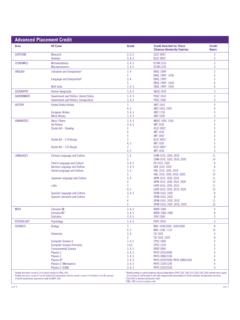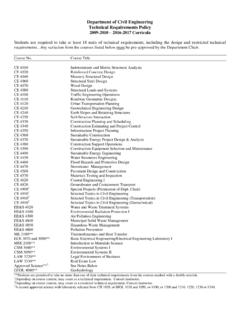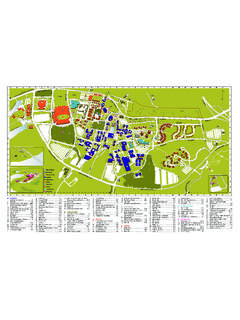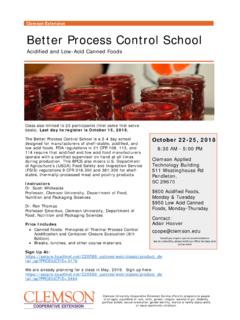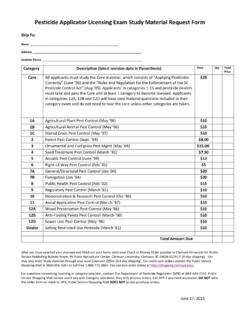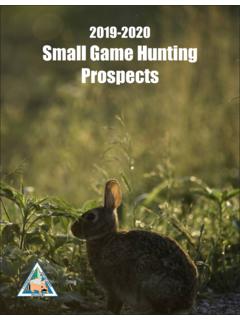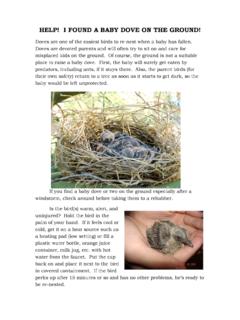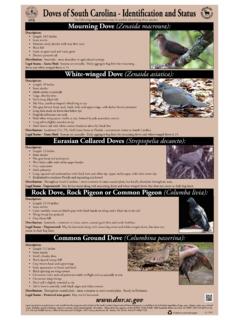Transcription of South Carolina’s Official Planting Guide for Mourning Dove ...
1 FW 16 - August 2017 Forestry & WildlifeAttracting and cultivating dove fields are popular techniques used by South carolina sportsmen, landowners, and land managers to attract doves, as well as to provide food and cover for a wide range of wildlife species. Careful planning, and an understanding of the legal guidelines for Planting and managing dove fields, is essential to producing a successful and legal dove field. Best management practices for establishing any successful supplemental plantings for wildlife enhance seed germination, plant growth, and provide nutrients for wildlife for prolonged periods of time. With proper planning and management, seeds produced by native broadleaf herbaceous plants ( ragweed, crotons, lespedezas, beggar-weeds, partridge pea) and native grasses ( panic grasses, paspalums, barnyard grass) can also provide food and cover for doves and other wildlife publication provides guidelines for establishing a variety of seed-producing plants preferred by doves in South carolina , as well as for common and legal small grain agricultural practices that also attract doves.
2 Although doves may be attracted using a variety of small grain agricultural practices, the intent of these practices is for agricultural purposes and not for the sole purpose of luring and attracting doves for shooting, which the Fish and South carolina s Official Planting Guide for Mourning Dove FieldsWildlife Service defines as baiting. In addition, many of these practices are short-term and do not provide long-term benefits and value to doves and other wildlife, as compared to a variety of well-established wildlife plantings that produce seed, forage, and cover for wildlife year-round. Practices Not Acceptable and Illegal1. Sowing seeds several times in succession on the same ground. 2. Piling, clumping, or concentrating small grains on the ground. 3. Except as provided by recommendations in this document, the Fish and Wildlife Service considers seeds freshly planted or otherwise distributed for the purpose of luring, attracting, or enticing doves within gun range to be baiting, and hunting doves in these areas is illegal.
3 Important Considerations Establishing dove fields with a variety of wildlife plantings provides food throughout the hunting season for doves and other wildlife. Certified Seed: Use of certified seed provides a level of insurance against poor germination, seed-borne diseases, and weeds. PVP varieties (covered under Mourning Dove (Zenaida macroura)Manipulating Crops is a Legal Practice for DovesRecommended Plantings for Doves and Agricultural Practices that Attract DovesPlant Planting Dates Planting DepthSpecies (maturing time) Seeding Rate and Method RecommendationsBrowntop MilletDove and White Proso MilletSunflowersCornSorghumSesame(Benne) May 1 July 15(60 - 70 days)May 1 July 1(80 - 90 days) April 15 July 1(110 - 120 days)March 1 April 30(150 days)May 15 July 1(80 - 140 days)May 1 June 15(120 - 150 days)Rows: 30 - 42 inches apart @ 8 - 10 lbs/acreDrilled: 20 - 35 lbs/acreBroadcast: 25 lbs/acreRows: 30 - 42 inches apart @ 8 - 10 lbs/ acreDrilled: 20 - 35 lbs/acreBroadcast: 25 lbs/acreSeeds 8 - 10 inches apart in rows 36 or 38 inches apart (6 - 10 lbs/acre)Rows: 36 - 40 inches apart @ 12 - 15 lbs/acre 3-5 plants/linear foot in rows 30-36 inches apart (usually 4 - 7 lbs/acre)Rows.)
4 36 or 38 inches apart @ 3 - 5 lbs/acre1/4 - 1/2 inch 1/4 - 1/2 inch1 1 inch1 - 1 inches1 inch1/2 inch Plant on well-prepared seedbed Plant 3 acres or more, 60-80 days before season Several plantings, 2-4 weeks apart If drilled, need to mow strips; can burn or rake mowed strips Soil test or 10-10-10 at 500 lbs/acre and pH - Plant on well-prepared seedbed Plant 3 acres or more Row Planting is best for doves If drilled, need to mow strips; can burn or rake mowed strips Soil test or 10-10-10 at 500 lbs/acre and pH - Plant on well-prepared seedbed Plant 5 acres or more May shred or mow a part of the field as season approaches Small-seeded oil-type sunflowers are preferred Require cultivation and herbicide to control weed competition Damage from deer browsing is likely Soil test or 10-10-10 at 500 - 600 lbs/acre and pH - Seed production enhanced by adding to1 lb boron/acre or following soil test recommendations Plant on well-prepared seedbed Leave corn standing around edge of field, harvest mechanically, burn after harvest.
5 Or use normal agricultural practices with seeds remaining in field Soil test and pH - Plant on well-prepared seedbed Known for being drought tolerant Soil test or 10-10-10 at 500 - 600 lbs /acre and pH - Plant on well-prepared seedbed 3-4 diskings in May before Planting will help control weeds Soil test or 10-10-10 at 500 - 600 lbs/acre and pH - Intent: Grown for grain production and harvest, or livestock grazing. Plant on well-prepared seedbed Soil test or 20 -50 lbs of nitrogen/acre and pH - Caution: Planting any earlier than November 1 for wheat may increase incidence of Hessian fly infestation. Intent: Used to reduce sheet and rill soil erosion and reduce runoff on tilled crop and pasture lands. Rye, oats and triticale recommended, wheat and barley are not recommended. Intent: Improve soil structure, soil organic matter, and provide weed suppression. Rye, oats and triticale recommended, wheat and barley are not recommended. Intent: Used to prevent soil erosion on disturbed areas.
6 Cultipack on bare soil to ensure seed to soil contact. Mulching with straw tons/acre to assist with germination. Used only on contours, drainages or land classified as highly erodible by NRCS guidelines. Caution: Planting any earlier than November 1 for wheat may increase incidence of Hessian fly infestation. Intent: To produce vegetation (forage) or seeds from plantings to provide supplemental food for wildlife (not the planted seeds themselves). Plant on well-prepared seedbed. Soil test or 20 -50 lbs of nitrogen/acre and pH - Caution: Planting any earlier than November 1 for wheat may increase incidence of Hessian fly - 1 inchesBroadcasting/aerial seeding is only recommended 1) into cotton prior to defoliation, 2) into peanuts prior to digging, 3) into soybeans prior to leaf drop, 4) prior to mowing crop residue in high residue crops, 5) on a prepared seedbed and cultipacked to ensure seed to soil contact, or 6) when covered with 1-1 inches of seeding is only recommended 1) into cotton prior to defoliation, 2) into peanuts prior to digging, 3) into soybeans prior to leaf drop, or 4) prior to mowing crop residue in high residue soil surface prior to optimal germination 1) cover seeds 1 1 inches with soil, or 2) evenly broadcast on well-prepared seedbed established with heavy tilling.
7 Drill 80 - 120 lbs/acreDrill 60 - 80 lbs/acre, or evenly broadcast 80 - 120 lbs/acreDrill 60 - 80 lbs/acre, or evenly broadcast 80 - 120 lbs/acreDrill 80 120 lbs/acre or evenly broadcast 120 -150 lbs /acreDrill 80 - 150 lbs/acre or evenly broadcast up to 200 lbs/ acreSmall Grains (wheat, oat, barley, rye, and triticale ) 1. Agronomic Crop Oct. 1 Nov. 30 Production or (230 - 260 days) Livestock Grazing 2. Cover Crop for Oct. 1 Nov. 30 Erosion Control (230 - 260 days) 3. Cover Crop for Oct. 1 Nov. 30 Soil Improvement (230 - 260 days) 4. Erosion Control Oct. 1 Nov. 30 (230 - 260 days)5. Wildlife Planting Oct. 1 Nov. 30 for Forage or (230 - 260 days) Grain ProductionRecommended Plantings for Doves and Agricultural Practices that Attract DovesPlant Planting Dates Planting DepthSpecies (maturing time) Seeding Rate and Method RecommendationsClemson University Cooperative Extension Service offers its programs to people of all ages, regardless of race, color, gender, religion, national origin, disability, political beliefs, sexual orientation, gender identity, marital or family status and is an equal opportunity fact sheet may be reprinted in its entirety for distribution.
8 If sections are re-used in other states, credit must be given to Clemson Extension and the : John Andrae, Associate Professor, Extension Forage Specialist, Clemson Cooperative Extension Service, Clemson UniversityMarion Barnes, Senior Extension Agent, Clemson Cooperative Extension Service, Clemson UniversityBilly Dukes, Assistant Chief of Wildlife, South carolina Department of Natural ResourcesDavid Gunter, Grain Specialist, Clemson Cooperative Extension Service, Clemson UniversityGordon Mikell, Conservation Agronomist, South carolina USDA Natural Resource Conservation ServiceDick Yetter, Wildlife Biologist, South carolina USDA Natural Resource Conservation ServiceGreg Yarrow, Chair and Professor, Department of Forestry and Environmental Conservation, Clemson Universitythe Plant Variety Protection Act) can only be saved for seed by the grower for use on their own land. Patented varieties cannot be saved for seed. Check with seed companies for legal requirements. To enhance dove use of fields, keep areas between rows weed-free by cultivating or using herbicides following label guidelines with special considerations to possible negative effects to pollinators and native bees.
9 Plan for at least a portion of the field to mature two weeks prior to hunting. Scout fields several weeks in advance of hunting to determine use by doves. Limit dove shooting to 1-2 days a week. Too much shooting will cause doves to move to other areas. Manipulating portions of the field by mowing, chopping, burning, or disking prior to hunting will help expose seeds and attract doves to the Proso Millet (Panicum miliaceum)Attracting


